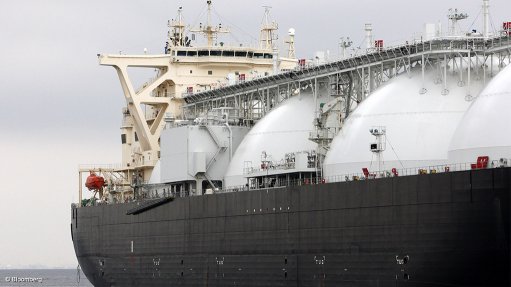
The development of liquefied natural gas (LNG) export capacity in countries such as the US and Australia is transforming gas into a “global energy market” and creating opportunities for countries such as South Africa to diversify its energy mix and bolster security of supply. This is the view of International Gas Union (IGU) president David Carroll, who participated in the organisation’s executive committee meeting in Durban this week.
He told Engineering News Online that the addition of significant LNG export capacity globally had already led to more affordable gas prices, as well as the prospect of “moderate pricing until supply and demand becomes much more balanced”.
Each country would develop its own energy policy and strategy, but Carroll argued that South Africa had a genuine opportunity to tap not only greater global LNG supply, but also domestic and regional sources of supply.
His statement came ahead of the much anticipated release, by the South African government’s Independent Power Producer (IPP) Office, of a request for proposals for the procurement of 3 136 MW of gas-to-power capacity.
Assessments were being made into the possibility of creating import infrastructure in Saldanha Bay, Coega and/or Richards Bay and Energy Minister Tina Joemat-Pettersson indicated recently that a two-phased approached would be pursued.
“We are planning to pre-qualify consortia of bidders who will have the opportunity to bid for the programme,” she wrote, indicating that the initiative could yield investments of around R64-billion in the coming four to five years.
“This will be spent in port, pipeline, power generation and transmission infrastructure,” the Minister wrote. The intention was also to use LNG imports to “ignite” the development of domestic upstream resources.
iGAS COO Dr Mike de Pontes, who participated in the IGU meeting on behalf of the State-owned company, itself a subsidiary of the Central Energy Fund, reported that work was under way to assess the creation of infrastructure to support LNG imports and the associated IPP programme.
However, economies of scale would be required, with De Pontes indicting that 2 000 MW of combined-cycle electricity generation would be required at a minimum to justify the creation of an import terminal.
“So of the 3 126 MW, you should put away in your mind one LNG terminal to fuel about 2 000 MW.” At such a scale, the “backbone” would be in place to easily increase capacity, primarily by raising ship frequency and by making modest investments to improve regasification capacity.
He also stressed the need for the South African programme to include viable capacity utilisation levels, indicating that it would be difficult to stimulate IPP investment purely on the basis of providing balancing power for intermittent renewable-energy plants.
“If you try and supplement when the sun doesn’t shine and the wind doesn't blow . . . it is difficult to create a constant contractual income coming from your LNG.”
Carroll stressed, nevertheless, the growing symbiotic relationship between natural gas and renewable-energy plants. “We see natural gas as a critical and key component to the future energy portfolio."
In addition, IGU secretary general Pål Rasmussen argued that gas was playing an important role in helping countries lower their carbon emissions, which had become a higher priority in light of the recent COP 21 agreement in Paris, France.